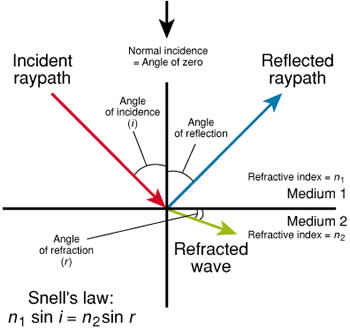

The refraction also has the ability to splitting up white light into its prominent colors. They are used in several everyday applications and also for specific scientific studies.Intensity The intensity of the diffraction fringes depends on the nature of incident light and the width of the slit. Thus, reflection, refraction and diffraction are three important properties of light, the effects of which are evident in nature. The phenomenon of diffraction is applied in making diffraction gratings, which are used for studying the structure of atoms and the composition of stars in space.

Mirrors are an application of the phenomenon of reflection, while lenses are an application of refraction.Diffraction, however, can only be explained if the wave theory of light is taken into consideration. Both reflection and refraction can be defined with the particle-only theory of light.Both reflection and diffraction can take place in the same medium. A change of media is required for refraction to take place.Diffraction is the spreading of light when it passes through a narrow opening or around an object. Refraction is the bending of light when it travels from one media to another. Reflection occurs when light bounces off a surface.Thus diffraction clearly indicates the wave-like nature of light.ĭiffraction of Light Reflection Vs Refraction Vs Diffraction This wouldn’t happen if light were just particles. The light waves get broken into different wave-fronts that converge at a point on the screen to produce the interference patter shown above. The result is that a pattern comprising alternate dark and light rings, is formed on the wall behind the coin. Light diffracted around the right edge of the coin interferes constructively and destructively with the light diffracted from its left edge.

This effect can be demonstrated with the following simple setup.Īs seen, a laser is used as a source of light and a coin is placed before it to block its path. Interference occurs due to diffraction of light around the sides of the object, which causes the shadow to become fuzzy. This is apparent when you notice the fuzziness around the edges of the shadow. However light also displays the wave-like quality of diffraction. When light encounters an obstacle in its path, it tends to cause the formation of a shadow in the region behind the obstacle. Water waves and sound waves have the ability to travel around corners, obstacles and through openings, and light waves too are able to display this ability. This occurrence advocated its wave-like behavior because if light was just a stream of particles, how could it bend around the sharp boundaries of the slit and continue moving similar to a water wave? He used it to describe the phenomenon where a single beam of light, when passed through a narrow slit, was able to split into different directions creating an interference pattern. The term ‘diffraction’ was first coined in the year 1660, by Italian physicist Francesco Grimaldi. However, the discovery of diffraction of light proved that it had wave-like qualities as well. Many of light’s behavior and properties led to the conclusion that it must be a stream of particles. Diffractionįor many years, scientists had debated on whether light is a linear stream of particles or a wave. Where V1 and V2 represent the different velocities of light in each medium, and n1 and n2 represent the refractive index of each medium.


 0 kommentar(er)
0 kommentar(er)
